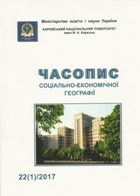Formation and distribution of international tourism flows in geographical space
Abstract
Properties of geographical space that are of key importance for international tourism, as length and discreteness, are analyzed in the article. Length makes tourists cover distances, whereas discreteness manifests itself in spatial heterogeneity. Tourism in conditions of homogeneous space is vain. That is, heterogeneity brings sense to travels as well as determines their direction. So, the effect of geographical space’s length and spatial heterogeneity on formation and distribution of tourism flows is assessed, international tourism’s geographical essence is disclosed also.
Apperception of geographical space in usual environment and its effect on tourist’s original motives are described. Following the bases of behaviorism, the tourism original motives, in particular those for migration, comfort, contrast and aesthetics are substantiated. The motive for migration is a kind of “pushing” tourists outside their usual environment. To stop all fears that may cause anxiety in destination, the latter should guarantee satisfaction of those human needs which A. Maslow refers to as basic needs. The necessity to satisfy these needs forms in tourists the motive for comfort. Closely located destinations in neighboring countries can be of little difference form usual environment. Driven by the motive for contrast, tourists aspire to visit places that totally differ from their usual environment, and contrast (are exotic to) it. Thus, the motive for contrast seemingly “pulls” the tourists up to certain (exotic) destinations.
Finally, following the considered spatial specificities of land surface and tourist-driving original motives, a conceptual model of formation and distribution of international tourism flows in geographical space is developed.
Downloads
References
2. Gold, J. (1990). Osnovy povedencheskoy geografii [Fundamentals of Behavioral Geography]. М.: Progress, 280.
3. Hagerstrand, T. (1970). What about people in regional science? Lund: Springer – Verlag.
4. Kotler, F. (2007). Osnovy marketinga [Fundamentals of Marketing]. М., “Williams” Publishing House, 656.
5. Lippmann, U. (2004). Obshhestvennoe mnenie [Public Opinion]. М.: Institute of the “Public Opinion” Fund, 384.
6. Pavlov I.P., Complete Works, 2nd edition, Vol. 4, Moscow-Leningrad, 1951.
7. Ishchuk, S.І., Hladkyy, О.V. (2015). Sotsіalna ta ekonomіchna geografіya: Teorіya і metodologіya [Social and Economic Geography: Theory and Methodology]. К., 335.
8. The Experience of Landscape Cognition (1975). Appleton.
9. Ukhtomskiy, А.А. (1966). Dominanta [Dominant]. Мoscow-Leningrad: Nauka, 271.
10. Boniface, B., Cooper, C. (2009). Worldwide Destinations: The Geography of Travel and Tourism. Elsevier Ltd. Fifth edition, 644.
Copyright (c) 2017 Oleksandr Korol

This work is licensed under a Creative Commons Attribution 4.0 International License.




